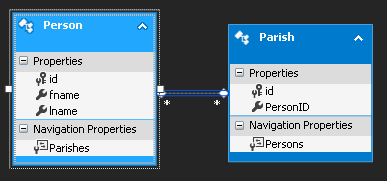A many-to-many relationship in CodeFirst is similar to a one-to-many relationship. The highlighted fields are the only lines you have to add, everything else is the same.

namespace g20161005_ChurchData
{
public class Person
{
public Person()
{
this.Parishes = new HashSet<Parish>();
}
public int id { get; set; }
public string fname { get; set; }
public string lname { get; set; }
public virtual ICollection<Parish> Parishes { get; set; }
}
public class Parish
{
public Parish()
{
this.Persons = new HashSet<Person>();
}
public int id { get; set; }
public int PersonID { get; set; }
public virtual ICollection<Person> Persons { get; set; }
}
}
The above class file has two classes: one for person, one for parish. A person can belong to more than one parish, and a parish can have many persons.
Think of it as a person can have parishes and a parish can have persons.
This is done via a linking table without payload.
The contexts file should look like:
using System.Data.Entity;
namespace g20161005_ChurchData
{
public class Contexts : DbContext
{
public DbSet<Person> Persons { get; set; }
public DbSet<Parish> Parishes { get; set; }
}
}
Finally, the calling code should look like this
namespace g20161005_ChurchData
{
class Program
{
static void Main(string[] args)
{
temp1();
}
static void temp1()
{
var cp = new Person
{
fname = "Greg",
lname = "Orcutt";
};
using (var Context = new Contexts())
{
Context.Persons.Add(cp);
Context.SaveChanges();
}
}
}
}
d
